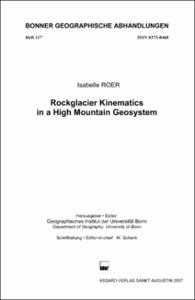Rockglacier Kinematics in a High Mountain Geosystem

Rockglacier Kinematics in a High Mountain Geosystem

| dc.contributor.author | Roer, Isabelle | |
| dc.date.accessioned | 2022-12-02T15:35:30Z | |
| dc.date.available | 2022-12-02T15:35:30Z | |
| dc.date.issued | 2007 | |
| dc.identifier.uri | https://hdl.handle.net/20.500.11811/10497 | |
| dc.description.abstract | The study presents a regional approach for the quantification of rockglacier creep in a high mountain geosystem (Turtmann valley, Swiss Alps).
By a combination of different methods, rockglacier movements were analysed qualitatively and quantitatively on various spatial and temporal scales. The application of digital photogrammetry and terrestrial geodetic survey enabled the quantification of horizontal velocities and vertical changes. The photogrammetric results demonstrate that small-scale aerial photographs are highly useflil to measure changes in rockglacier geometry. Also the combination with high resolution imagery (from HRSC-A), which was applied for the first time in rockglacier studies, has been successful. Thus, displacements were investigated in a large area (meso-scale) and over a time span of 26 years (1975 - 2001). Against that, terrestrial geodetic survey enabled the annual quantification of block displacements on two rockglaciers between 2001 and 2004. The first-time application of dendrogeomorphic techniques for the determination of permafrost creep provided preliminary results for two rockglaciers. The applied techniques and especially the combination of geomorphic mapping and digital photogrammetry allowed the reliable assessment of the State of activity for 45 rockglaciers. Horizontal and vertical surface changes were analysed on 34 rockglaciers and a clear activity was revealed on 18 of them. Most of the permafrost bodies indicated above-average horizontal velocities compared to other rockglaciers in the Alps. In addition, conspicuous spatio-temporal variations in horizontal velocities and vertical changes were observed. Regarding the temporal variations, a distinct increase in horizontal velocity - probably from the beginning of the 1990s - was ascertained for all investigated active rockglaciers. The described findings were discussed by consideration of probable controls, such as terrain parameters and climatic influences. Although the data on decisive forcing factors and the knowledge on rockglacier dynamics is limited, it is assumed that the observed speed-up is linked to climatic changes and an increase in ground temperatures, respectively. Thus, the investigated kinematics supports the role of rockglaciers as sensitive indicators for changes in the high mountain geosystem. | en |
| dc.format.extent | 242 | |
| dc.language.iso | eng | |
| dc.relation.ispartofseries | Bonner Geographische Abhandlungen ; 117 | |
| dc.rights | In Copyright | |
| dc.rights.uri | http://rightsstatements.org/vocab/InC/1.0/ | |
| dc.subject | Dendrogeomorphologie | |
| dc.subject | Eis | |
| dc.subject | Geodäsie | |
| dc.subject | Geomorphology | |
| dc.subject | Gletscher | |
| dc.subject | Hochgebirge | |
| dc.subject | Luftbild | |
| dc.subject | Messungen | |
| dc.subject | Methoden | |
| dc.subject | Schweiz | |
| dc.subject | Theorie | |
| dc.subject | Wallis | |
| dc.subject | Turtmanntal | |
| dc.subject | Blockgletscher | |
| dc.subject | Kinematik | |
| dc.subject | Geomorphologische Kartierung | |
| dc.subject | Fotogrammetrie | |
| dc.subject.ddc | 526.1 Geodäsie | |
| dc.subject.ddc | 526.982 Fotogrammetrie | |
| dc.subject.ddc | 550 Geowissenschaften | |
| dc.subject.ddc | 910 Geografie, Reisen | |
| dc.title | Rockglacier Kinematics in a High Mountain Geosystem | |
| dc.type | Dissertation oder Habilitation | |
| dc.publisher.name | Asgard-Verlag | |
| dc.publisher.location | Sankt Augustin | |
| dc.rights.accessRights | openAccess | |
| dc.relation.pissn | 0373-0468 | |
| dc.relation.pisbn | 3-537-87667-X | |
| ulbbn.pubtype | Zweitveröffentlichung |




